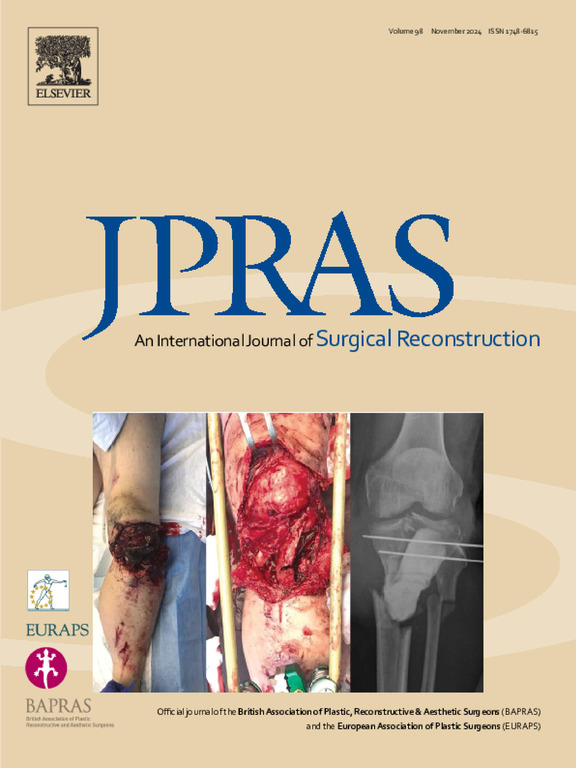Oral function in facial nerve palsy: A comparative analysis of flaccid and synkinetic palsy
IF 2
3区 医学
Q2 SURGERY
Journal of Plastic Reconstructive and Aesthetic Surgery
Pub Date : 2025-05-21
DOI:10.1016/j.bjps.2025.04.055
引用次数: 0
Abstract
Background
Facial nerve palsy (FNP) can have a profound impact on oral function and quality of life (QOL). However, the distinct challenges encountered by patients with flaccid compared with synkinetic facial movements have not been characterised. This study aimed to describe and compare speech, swallowing and QOL in patients with these 2 conditions.
Methods
Patients with lower motor neurone FNP were recruited from the Sydney Facial Nerve Service. Their oral competence was measured using clinician- and patient-rated outcome measures. This included a consonant analysis of a recorded reading sample and a subjective intelligibility rating by the clinician and patient and 2 validated questionnaires, the Speech Handicap Index (SHI) and Oral Competence Questionnaire (OCQ).
Results
Sixty-five participants were enrolled in the study (n=16 intact facial nerve function, prior to facial nerve sacrifice surgery, n=31 synkinetic FNP and n=18 flaccid FNP). The flaccid FNP group presented with more speech errors within each consonant group (p<0.001), poorer intelligibility in clinician and patient ratings (p<0.001 and p=0.01, respectively) and in the OCQ responses (p=0.01). No significant difference was observed in the SHI between the synkinetic and flaccid groups.
Conclusions
Flaccid and synkinetic FNP are 2 distinct conditions, presenting with differing characteristics and requiring different treatment pathways. These findings suggest that patients with flaccid FNP present with poorer functional outcomes in swallowing and speech-related QOL.
面神经麻痹的口腔功能:弛缓性和共动性麻痹的比较分析。
背景:面神经麻痹(FNP)对口腔功能和生活质量(QOL)有深远的影响。然而,与共动性面部运动相比,松弛患者所遇到的独特挑战尚未被表征。本研究旨在描述和比较这两种疾病患者的言语、吞咽和生活质量。方法:从悉尼面神经中心招募下运动神经元FNP患者。他们的口腔能力是用临床医生和患者评价的结果测量来测量的。这包括对记录阅读样本的辅音分析和临床医生和患者的主观可理解度评分,以及2份有效的问卷,言语障碍指数(SHI)和口语能力问卷(OCQ)。结果:65名参与者入组研究(n=16例完整面神经功能,面神经牺牲手术前,n=31例共动性FNP和n=18例弛缓性FNP)。结论:弛缓性和共动性FNP是两种不同的情况,表现出不同的特征,需要不同的治疗途径。这些发现表明,FNP弛缓性患者在吞咽和言语相关生活质量方面存在较差的功能结局。
本文章由计算机程序翻译,如有差异,请以英文原文为准。
求助全文
约1分钟内获得全文
求助全文
来源期刊
CiteScore
3.10
自引率
11.10%
发文量
578
审稿时长
3.5 months
期刊介绍:
JPRAS An International Journal of Surgical Reconstruction is one of the world''s leading international journals, covering all the reconstructive and aesthetic aspects of plastic surgery.
The journal presents the latest surgical procedures with audit and outcome studies of new and established techniques in plastic surgery including: cleft lip and palate and other heads and neck surgery, hand surgery, lower limb trauma, burns, skin cancer, breast surgery and aesthetic surgery.

 求助内容:
求助内容: 应助结果提醒方式:
应助结果提醒方式:


